Abstract
In this study, we used 0.2C-1.7Si-1.9Mn wt% cold-rolled sheet as the experimental material to prepare the Q&P sample with blocky microstructures and the QQ&P sample with lath-shaped microstructures through the Q&P and QQ&P processes, respectively. The partitioning behavior of carbon and manganese in the two samples after intercritical annealing and partitioning were studied. During the intercritical annealing, the partitioning of carbon and manganese in the Q&P and the QQ&P samples occurred, resulting in the contents of carbon and manganese being significantly higher than those in the ferrite. Meanwhile, due to the migration of the ferrite–austenite interface during the formation of the austenite, the distributions of carbon and manganese in the lath-shaped and blocky austenite were both homogenous. The morphology of the microstructures had little influence on the distribution of carbon and manganese in metastable austenite during intercritical annealing. In the partitioning, the migration of the ferrite–austenite interface and diffusion of manganese can be ignored. Carbon first diffuses from the ferrite grains to the ferrite–austenite interface and then diffuses in the austenite grains. The morphology of the microstructures has a great effect on the homogenization of carbon in austenite grains. Compared with coarse blocky austenite, lath-shaped austenite can shorten the diffusion path of carbon in austenite grains and increase the homogeneity of carbon in austenite grains, thereby improving the thermal stability of lath-shaped austenite. Compared with the Q&P sample, the QQ&P sample has higher content of retained austenite (14.74% vs. 13.96%), better elongation (25.9% vs. 19.2%), and higher product of strength and elongation (27.5 GPa% vs. 24.4 GPa%).
1. Introduction
The development of advance high strength steels (AHSSs) involves achieving an optimum combination of high strength and high ductility. The quenching and partitioning (Q&P) process, initially proposed by Speer et al. [1,2], is a promising and innovative heat treatment to prepare third-generation AHSS. It has been recognized that one of the most important microstructures that allows the optimum balance between strength and ductility in Q&P steel is retained austenite [3,4,5]. It is believed that the volume fraction of retained austenite in Q&P steel is influenced by the thermal stability of metastable austenite [6,7]. The existence of retained austenite in Q&P steel is related to the partitioning of carbon from oversaturated martensite to metastable austenite in the partitioning stage, thus improving the thermal stability of retained austenite [1,2]. In addition, some studies [8,9,10] indicated that the partitioning of manganese from ferrite to metastable austenite during intercritical annealing can also improve the thermal stability and volume fraction of retained austenite in Q&P steel. Therefore, it can be concluded that improving the concentration of carbon and manganese in metastable austenite is an important way to increase the volume fraction of retained austenite in Q&P steel.
The partitioning of carbon and manganese from martensite/ferrite to austenite includes the diffusions of carbon and manganese from the inside of the martensite/ferrite to the martensite/ferrite–austenite interface, followed by homogenization in the austenite grains. The morphology of the microstructures has an important effect on the partitioning of carbon and manganese in the Q&P process. For instance, compared with the blocky microstructures, the lath-shaped microstructures will increase the area of the martensite/ferrite–austenite interface and shorten the diffusion paths of carbon and manganese, thus promoting the enrichment and homogenization of carbon and manganese in austenite grains. Zhang et al. [11] proposed pre-quenching + Q&P (QQ&P) heat treatment, a process that can prepare lath-shaped ferrite and retained austenite. Compared with the Q&P sample with blocky microstructures, the QQ&P sample has a higher content of retained austenite, thereby achieving a better combination of strength and ductility. Similar results were also indicated by the studies of Ren et al. [12] and Ding et al. [13]. Our previous work [14] also found that lath-shaped microstructures can enhance the thermal stability of metastable austenite and inhibit the formation of secondary martensite, thereby improving the mechanical properties of Q&P steel. Nevertheless, the Q&P process includes full/intercritical austenitizing, quenching, and partitioning. The diffusion rates of carbon and manganese in each stage are significantly different. At present, there are few studies on the influence of the microstructure morphology on the partitioning of carbon and manganese at various stages of the Q&P process, resulting in the influence mechanism of microstructure morphology on the thermal stability of retained austenite being unclear.
Therefore, to study the effect of the microstructure morphology of Q&P steel on the partitioning of carbon and manganese, we prepared the Q&P sample with blocky microstructures and the QQ&P sample with lath-shaped microstructures by adopting the Q&P and QQ&P processes, respectively. The partitioning behaviors of carbon and manganese in the two samples after intercritical annealing and partitioning were analyzed by an electron probe microanalyzer (EPMA).
2. Experimental Procedure
The experimental steel was ~1.3 mm cold-rolled (CR) 0.2C-1.7Si-1.9Mn wt% sheets, which were prepared by subjecting the hot-rolled (HR) commercial sheets to 35% cold reduction in thickness. The Q&P sample was prepared by rapidly heating the CR sheet to 810 °C and holding for 180 s before undergoing an immediate quench (first quenching) to 260 °C for 15 s in a salt bath and another salt bath at 400 °C for 50 s. Last, the sample was quenched (second quenching) in water to room temperature (RT). The QQ&P sample was treated in the same way as the Q&P sample, but with a pre-quenching process involving austenitizing at 920 °C for 180 s and then quenching to RT. To study the partitioning of carbon and manganese during the intercritical annealing, the CR and pre-quenching samples were rapidly heated to 810 °C and held for 180 s, then directly quenched to RT. The two samples were named Q-RT and QQ-RT, respectively.
The above samples for the EPMA (8050G) studies were mechanically polished and then etched in 4 vol% nital solution for 3 s. The samples for the scanning electron microscope (SEM, Nova nano 400, FEI Company, Hillsboro, OR, USA) studies were treated in the same way as the EPMA samples, but with an etching time of 10 s. The electron backscatter diffraction (EBSD, ThermoFisher, Waltham, MA, USA) samples were electrochemically etched in 5% perchloric acid alcohol at 25 °C with a current of 0.6 A and voltage of 28 V for about 30 s. The EBSD measurement was carried out at a step size of 50 nm. The transmission electron microscope (TEM, JEM-2100, Tokyo, Japan) samples were thinned to a thickness of 40–80 µm and then punched into 3 mm-diameter discs. The discs were finally electro-polished with a twin-jet machine at −25 °C in a solution of perchloric acid and alcohol. The volume fraction of retained austenite was measured by X-ray diffraction (XRD, Panalytical, Almelo, The Netherlands) with Cu Kα radiation. The integrated intensities of the (200)γ, (220)γ, (311)γ, (200)α, and (211)α peaks were used to quantify the volume fraction of retained austenite by [15]:
where V is the volume fraction of retained austenite, G is the coefficient corresponding to each combination, Iγ is the integrated intensity of the FCC reflection peaks, and Iα is the integrated intensity of the BCC reflection peaks.
The carbon content of retained austenite was quantified by [16]:
where αγ is the lattice constant of austenite (nm); and correspond to the mass fractions of carbon and manganese in austenite (%).
The tensile samples have a profile of 93 × 20 mm. The gage length and width of the samples were 30 mm and 12.5 mm, respectively. Tensile tests were conducted at a strain rate of 5 × 10−4 s−1 using a CMT5304 tensile machine at room temperature. Each sample was tested three times to obtain an average value for each mechanical property.
3. Results
3.1. Microstructures of QQ&P and Q&P Samples
The SEM micrographs of the CR and pre-quenching sheets before Q&P treatment are shown in Figure 1(a1,b1), respectively. The microstructures of the CR sheet are mainly composed of ferrite and martensite. After the full austenitizing and quenching, the microstructure of the sheet is predominantly martensite laths. The carbon and manganese distributions corresponding to the microstructures of the CR (Figure 1(a2,a3)) and pre-quenching sheets (Figure 1(b2,b3)) were measured by EPMA. The results indicate that the carbon content of martensite in the CR sheet is obviously higher than that of ferrite. In addition, there are a certain number of carbon-enriched particles distributed in the martensite, which may be carbides (Figure 1(a2)). Different from the carbon distribution, the manganese distribution in the CR sheet is uniform (Figure 1(a3)). After pre-quenching, the number of carbon-enriched particles decreased, and the carbon distribution become uniform (Figure 1(b2)). Compared with the CR sheet, the distribution of manganese in the pre-quenching sheet is basically unchanged (Figure 1(b3)).
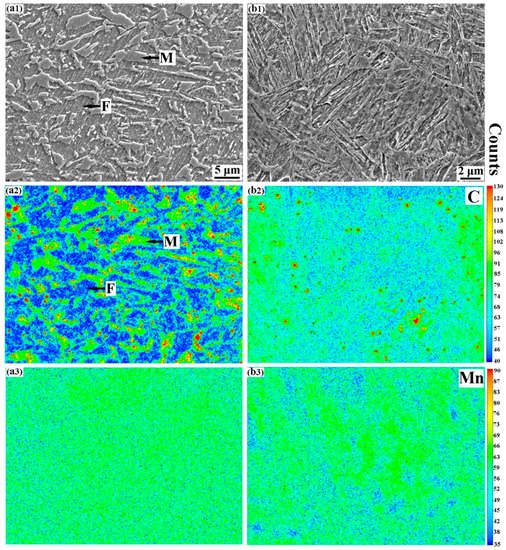
Figure 1.
(a1,b1) Secondary electron micrographs and map scanning micrographs of (a2,b2) carbon and (a3,b3) manganese of (a1–a3) CR and (b1–b3) pre-quenching samples.
The SEM micrographs of the Q&P and QQ&P samples are shown in Figure 2a,b, respectively. M1 in the figures refers to the primary martensite that forms during the first quenching. LF and BF refer to lath-shaped and blocky ferrite, respectively. L-RA and B-RA refer to lath-shaped and blocky retained austenite, respectively. M2/A island refers to secondary martensite/retained austenite. M2 forms during the second quenching to room temperature. The ferrite, M1, retained austenite, and M2/A island can be identified by their different responses [17,18]. The image quality micrographs of the Q&P and QQ&P samples analyzed by EBSD are shown in Figure 2c,d, respectively. Austenite with the FCC crystal structure is highlighted in green. Ferrite and M1 with the BCC crystal structures are shown in grey. The light grey refers to ferrite, and the dark grey refers to M1. Considering the high defect densities and large quantities of substructures that contribute to the low image quality, the dark region represents M2 [19]. The microstructures of the Q&P and QQ&P samples mainly consist of ferrite, M1, retained austenite, and the M2/A island. However, there are significant differences in the microstructures between the Q&P and QQ&P samples. Firstly, the ferrite in the Q&P sample is in the shape of fine blocks and coarse irregularities, but mainly present as lath in the QQ&P sample. Secondly, the retained austenite distributed at the grain boundary of blocky ferrite and along the longitudinal direction of lath-shaped ferrite present the block and lath, respectively, resulting in the retained austenite in the Q&P sample mainly present as the block, but present as the lath in the QQ&P sample. Lastly, the number of M2/A islands in the Q&P sample is more than that in the QQ&P sample.
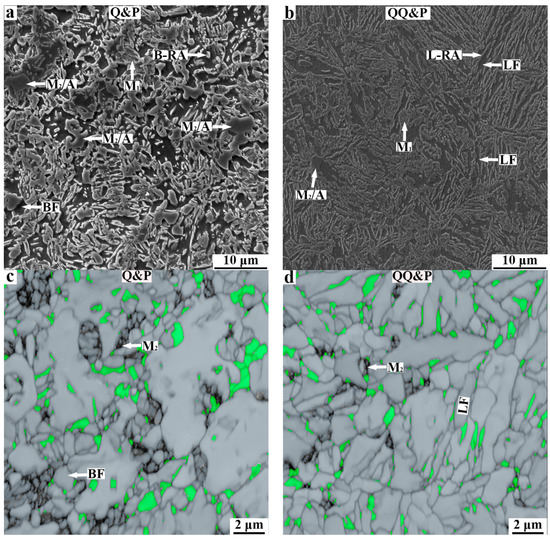
Figure 2.
(a,b) SEM and (c,d) EBSD micrographs of QQ&P and Q&P samples. M2/A, M1, B-RA, and BF in (a) refer to secondary martensite/retained austenite, primary martensite, blocky retained austenite, and blocky ferrite. LF in (b,d) refers to lath-shaped ferrite.
Figure 3 shows the typical TEM microstructures of the Q&P and QQ&P samples. The TEM micrographs indicate that the coarse irregular ferrite grains and fine blocky recrystallized ferrite grains are simultaneously present in the Q&P sample (Figure 3a). The bright and dark fields of the M2/A island are shown in Figure 3b,c, respectively. The M2/A islands are distributed in the adjacent area of blocky ferrite. The lath-shaped retained austenite in the QQ&P sample is distributed along the lath-shaped ferrite (Figure 3d), which is consistent with the EBSD results (Figure 2d). The bright and dark fields of lath-shaped retained austenite are shown in Figure 3e,f, respectively.
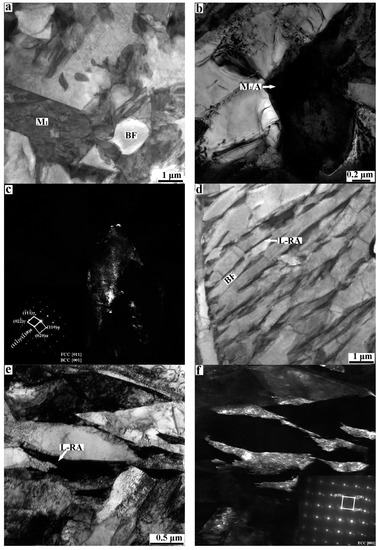
Figure 3.
Typical TEM micrographs of the (a–c) Q&P and (d–f) QQ&P samples. (b,c) are the bright and the dark fields of the M2/A island, respectively. (e,f) are the bright and the dark fields of lath-shaped retained austenite, respectively.
The comprehensive XRD patterns of the QQ&P and Q&P samples are shown in Figure 4. The patterns indicate that the intensities of (200)α and (211)α in the Q&P sample are higher than their counterparts in the QQ&P sample. The contents of retained austenite in the QQ&P and Q&P samples are also presented in Figure 4. The results show that the volume fraction and average carbon content of retained austenite in the Q&P sample are both lower than those in the QQ&P sample.
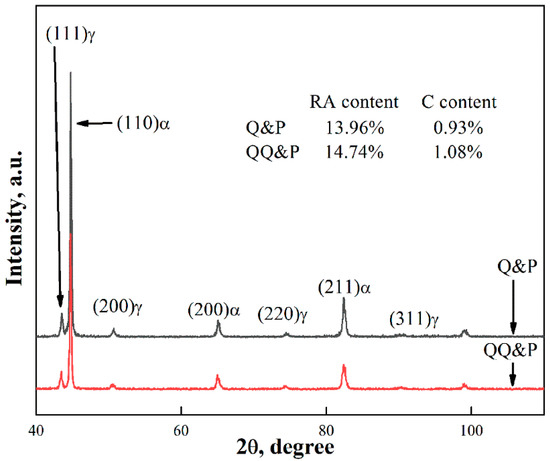
Figure 4.
XRD patterns of Q&P and QQ&P samples. The volume fraction and average carbon content of retained austenite in Q&P and QQ&P samples are also presented in the figure.
3.2. Diffusions of Carbon and Manganese during Q&P Process
To analyze the effect of the microstructure morphology on the diffusions of carbon and manganese during Q&P treatment, we selected the Q-RT, QQ-RT, Q&P, and QQ&P samples and analyzed their microstructures and corresponding carbon and manganese distributions. The austenite formed during the intercritical annealing will transform into martensite during the quenching to RT. Under rapid cooling, the diffusions of carbon and manganese during the quenching stage can be neglected. Therefore, the distributions of carbon and manganese in martensite of the Q-RT and QQ-RT samples are consistent with those in austenite after intercritical annealing. The results indicate that the ferrite in the Q-RT (Figure 5(a1)) and QQ-RT (Figure 5(b1)) samples is mainly present as the block and lath, respectively, which is consistent with the Q&P and QQ&P samples. The quenched martensite in the two samples mainly presented the coarse blocky morphology. In addition, some granular retained austenite/martensite is distributed in the blocky ferrite of the Q-RT sample. Different from the Q-RT sample, there are some lath-shaped retained austenite/martensite distribute along the lath-shaped ferrite in the QQ-RT sample. In the Q-RT and QQ-RT samples, the contents of carbon (Figure 5(a2,b2)) and manganese (Figure 5(a3,b3)) in martensite are higher than those in ferrite. In addition, the distributions of carbon and manganese in martensite are uniform, meaning that carbon and manganese are homogeneously distributed in the austenite of the two samples after intercritical annealing. The line scanning of carbon and manganese distributions corresponding to the different microstructures of the Q-RT and QQ-RT samples are shown in Figure 6a,b, respectively. Similar to the results of map scanning, the carbon and manganese contents of martensite or retained austenite in the two samples are higher than those of ferrite. It should be noted that the content of carbon and manganese inside ferrite, at the ferrite–martensite/austenite interface, and inside martensite/austenite increase first and then basically remain unchanged.
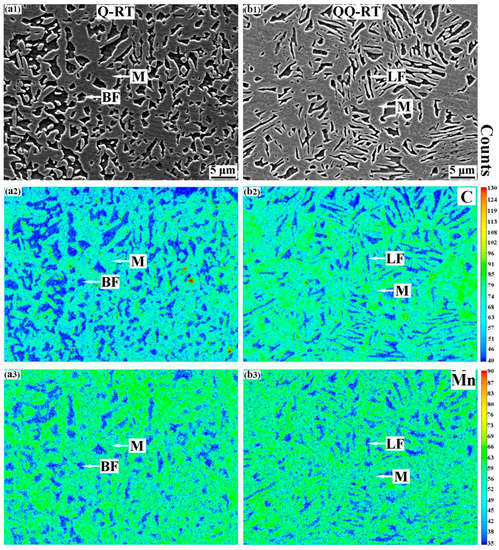
Figure 5.
(a1,b1) Secondary electron micrographs and map scanning micrographs of (a2,b2) carbon and (a3,b3) manganese of (a1–a3) CR and (b1–b3) pre-quenching samples after intercritical annealing and quenching.
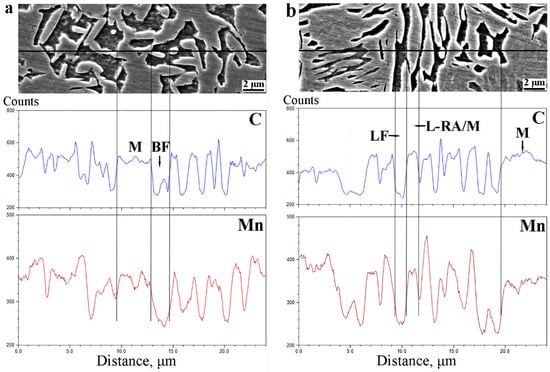
Figure 6.
Secondary electron micrographs and line scanning micrographs of carbon and manganese of (a) CR and (b) pre-quenching samples after intercritical annealing and quenching.
The map scanning of the carbon and manganese distributions corresponding to different microstructures of the Q&P and QQ&P samples are shown in Figure 7. The results indicate that the contents of carbon and manganese in the M2/A islands and blocky retained austenite of the Q&P sample are higher than those in blocky ferrite. The distribution of carbon in the M2/A islands is heterogeneous. The carbon content at the boundary is significantly higher than that inside the islands (Figure 7(a2)). However, this heterogeneous phenomenon is not significant in the distribution of manganese (Figure 7(a3)). Unlike the heterogeneous distribution of carbon in the M2/A islands, the carbon distribution is more homogeneous in the lath-shaped retained austenite (Figure 7(b2)). The line scanning of carbon and manganese distributions corresponding to different microstructures of the Q&P and QQ&P samples is shown in Figure 8a,b, respectively. The results indicate that the contents of carbon and manganese in the blocky ferrite grains are significantly lower than those at the ferrite–austenite interface. Similar distribution laws are also present in the lath-shaped ferrite of the QQ&P sample. However, the distribution of carbon in the M2/A islands is significantly different with that of manganese. The carbon content inside the M2/A islands is significantly lower than that at the boundary, while the manganese content inside the M2/A islands is close to that at the boundary. In addition, the content of carbon in the lath-shaped retained austenite of the QQ&P sample is significantly higher than that in M2/A islands.
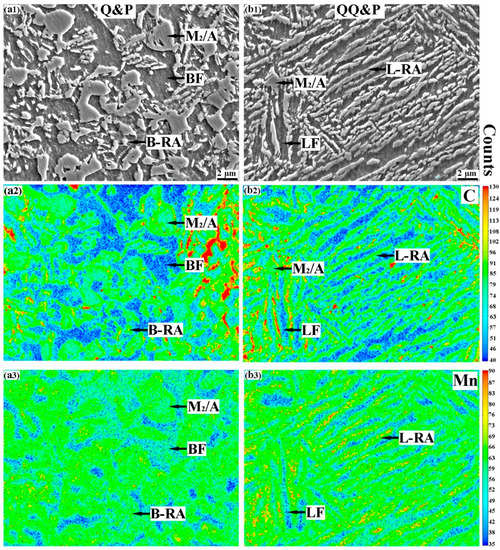
Figure 7.
(a1,b1) Secondary electron micrographs and map scanning micrographs of (a2,b2) carbon and (a3,b3) manganese of (a1–a3) Q&P and (b1–b3) QQ&P samples.
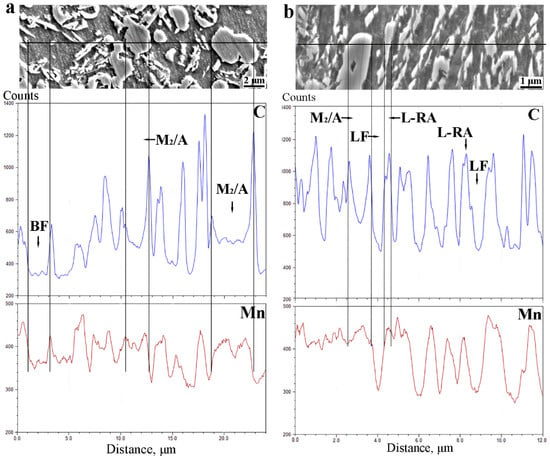
Figure 8.
Secondary electron micrographs and line scanning micrographs of carbon and manganese of (a) Q&P and (b) QQ&P samples.
The engineering stress–strain plots of the QQ&P and Q&P samples are shown in Figure 9. Compared with the Q&P sample, the QQ&P sample has similar yield strength, lower tensile strength, and higher elongation. The product of strength and elongation (PSE) of the Q&P and QQ&P samples is 24.4 GPa% and 27.5 GPa%, respectively.
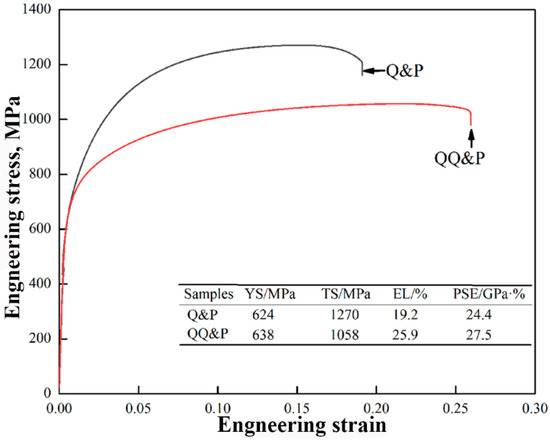
Figure 9.
The engineering stress–strain plots of Q&P and QQ&P samples. The yield strength, tensile strength, elongation, and PSE of the two samples are also presented in the figure.
4. Discussions
4.1. The Effect of Initial Structures on the Microstructure Morphology in Q&P and QQ&P Samples
The initial structures of the CR sheet are mainly deformed ferrite and martensite. During cold rolling, dislocations and deformation bands will form in ferrite grains [20], increasing the stored energy. The stored energy can provide a driving force for the ferrite recovery and recrystallization upon intercritical annealing. Due to the high storage energy of the CR sheet, recrystallized ferrite can grow into the blocky shape. That is the reason why the morphology of the ferrite in the Q&P sample is mainly block. Austenite distributed at the boundaries of blocky ferrite grains tends to grow into blocky shape [21], explaining why the retained austenite is mainly blocky type in the Q&P sample.
After pre-quenching, the initial structure of the CR sheet transforms into lath-shaped martensite. During intercritical annealing, austenite reversed transformation (ART) will occur, which can be summarized as follows: (1) carbide precipitation and austenite nucleation at the beginning, (2) the formation of austenite laths between the martensite laths, during which the carbides and dislocations of martensite are consumed, and (3) the complete formation of the duplex structure of lath-shaped austenite and ferrite [22]. Lath-shaped austenite with high carbon and manganese content and fine grain size is beneficial to obtain high thermal stability [23]. Therefore, most lath-shaped retained austenite can be retained to RT after quenching and partitioning. This is the reason why the morphologies of the ferrite and retained austenite in the QQ&P samples are mainly lath-shaped.
4.2. The Effect of Microstructure Morphology on Carbon and Manganese Diffusions during Q&P Treatments
The solid solubility of carbon and manganese in the austenite phase is significantly higher than that of ferrite. During the intercritical annealing, austenite preferentially nucleates at carbon-enriched areas, such as cementite precipitates [24]. The growth of austenite is controlled by the diffusions of carbon and manganese [25,26,27], resulting in the austenite–ferrite interface migrating to the carbon- and manganese-enriched areas. Therefore, the contents of carbon and manganese in the austenite grains are close to those at the boundary (M in Figure 6a,b). In addition, the high annealing temperature could improve the diffusion rates of carbon and manganese. The time required for the homogenization of carbon and manganese in austenite is short. The morphology of the microstructures has little influence on the homogenization of carbon and manganese in austenite grains, which may be the reason why carbon and manganese are distributed homogeneously in both blocky martensite and lath-shaped retained austenite/martensite (M and L-RA/M in Figure 6).
According to the “Constrained Carbon Equilibrium” (CCE) model proposed by Speer et al. [2], during the partitioning, only carbon diffusion occurs, and the austenite-martensite interface remains unchanged. This is significantly different from the diffusion behavior of carbon and manganese in the intercritical annealing, which could be attributed to the fact that the partitioning temperature is significantly lower than the annealing temperature. During the partitioning, carbon will be enriched at the martensite/ferrite–austenite interface first and then diffuses in the austenite grains. Compared with coarse blocky austenite, the diffusion path of lath-shaped austenite is shorter, which is conducive to the homogenization of carbon in the lath-shaped austenite grains (L-RA in Figure 8b). Because the diffusion rate of carbon in austenite grains is obviously slower than that in the martensite–ferrite interface [28], the carbon at the austenite boundary has no time to diffuse in the grains, resulting in the carbon content in coarse blocky austenite grains being obviously lower than that at the boundary (M2/A in Figure 8). This part of austenite with lower thermal stability is easy to transform into M2 during quenching to RT, thereby forming M2/A islands and reducing the retained austenite content of the Q&P sample.
The diffusion rate of manganese is much lower than that of carbon. The study of Gouné et al. [29] indicated that the diffusion distance of manganese at the martensite–austenite interface is only a few nanometers when carbon partitioning is completed. The “CCE” model also assumes that manganese does not undergo short-range diffusion at the martensite–austenite interface during the partitioning [2]. Therefore, the effect of the microstructure morphology on the diffusion of manganese in the partitioning can be neglected. This is the reason why the distribution law of manganese in M2/A islands is significantly different from that of carbon. In conclusion, the microstructure morphology of Q&P steel can affect the diffusion of carbon in austenite grains during the partitioning. The lath-shaped austenite can improve the homogenization of carbon in grains, thereby improving the thermal stability of austenite. This is the reason why the retained austenite content in the QQ&P sample is higher than that in the Q&P sample.
4.3. The Relationship between Microstructures and Mechanical Properties of Q&P and QQ&P Samples
Compared with the Q&P sample, the QQ&P samples have higher elongation. This may be related to the following reasons. Firstly, the carbon content and volume fraction of the retained austenite in the QQ&P sample are both higher than those in the Q&P sample. The lath-shaped retained austenite with higher carbon content will exhibit higher mechanical stability [30,31,32]. The retained austenite in the QQ&P sample with higher content and higher mechanical stability is helpful to expand the range of the transformation-induced plasticity (TRIP) effect, thus improving the elongation of the QQ&P sample. Secondly, the study of Sun et al. [33] indicated that there is an angle between some lath-shaped microstructures and the tensile direction. The lath-shaped microstructures are more prone to instability and rotation during the deformation process. The rotation of lath-shaped microstructures can release energy and reduce the stress concentration, thereby improving elongation. Lastly, the Q&P sample has a higher content of M2. Since it was not tempered, M2 has higher strength, but a lower plastic deformation ability [34]. Therefore, the stress concentration can readily occur at its interface, reducing the elongation of the Q&P sample.
5. Conclusions
- (1)
- During the intercritical annealing, the partitioning of carbon and manganese in the Q&P and the QQ&P samples occurred, and the carbon and manganese contents in austenite are significantly higher than those in ferrite.
- (2)
- The microstructure morphology of the Q&P sample will affect the diffusion of carbon in metastable austenite grains during the partitioning stage. Compared with blocky austenite, lath-shaped austenite can shorten the diffusion path of carbon in austenite grains, increase the homogenization of carbon in austenite grains, thereby improving the thermal stability of lath-shaped austenite.
- (3)
- Compared with the Q&P sample with blocky microstructures, the QQ&P sample with lath-shaped microstructures has higher content of retained austenite (14.74% vs. 13.96%), better elongation (25.9% vs. 19.2%), and higher PSE (27.5 GPa% vs. 24.4 GPa%).
Author Contributions
Conceptualization, G.Z. and D.X.; methodology, D.X.; investigation, H.X. and Y.C.; data curation, H.X.; writing—original draft preparation, H.X. and D.X.; writing—review and editing, S.B. and G.Z. All authors have read and agreed to the published version of the manuscript.
Funding
This research was funded by the National Key Research and Development Program (No. 2021YFB3702402) and the financial support from the Postdoctoral Science Foundation of China (No. 2020M682494).
Institutional Review Board Statement
Not applicable.
Informed Consent Statement
Not applicable.
Data Availability Statement
All data are available from the corresponding author upon reasonable request.
Acknowledgments
The authors would like to acknowledge Analytical & Testing Center of Wuhan University of Science and Technology for the help on EBSD and EPMA analysis.
Conflicts of Interest
The authors declare no conflict of interest.
References
- Speer, J.G.; Matlock, D.K.; Cooman, B.C.D.; Schroth, J.G. Carbon partitioning into austenite after martensite transformation. Acta Mater. 2003, 51, 2611–2622. [Google Scholar] [CrossRef]
- Speer, J.G.; Matlock, D.K.; Cooman, B.C.D.; Schroth, J.G. Comments on “On the definitions of paraequilibrium and orthoequilibrium” by Hillert, M. and Ågren, J. Scr. Mater. 2004, 50, 697–699, Erratum in Scr. Mater. 2005, 52, 83–85. [Google Scholar]
- Tan, X.D.; Xu, Y.B.; Ponge, D.; Yang, X.L.; Hu, Z.P.; Fei, F.; Ju, X.W.; Wu, D.; Raabe, D. Effect of intercritical deformation on microstructure and mechanical properties of a low-silicon aluminum-added hot-rolled directly quenched and partitioned steel. Mater. Sci. Eng. 2016, A 656, 200–215. [Google Scholar] [CrossRef]
- Liu, L.; He, B.B.; Cheng, G.J.; Yen, H.W.; Huang, M.X. Optimum properties of quenching and partitioning steels achieved by balancing fraction and stability of retained austenite. Scr. Mater. 2018, 150, 1–6. [Google Scholar] [CrossRef]
- Finfrock, C.B.; Clarke, A.J.; Thomas, G.A.; Clarke, K.D. Austenite stability and strain hardening in C-Mn-Si quenching and partitioning steels. Metall. Mater. Trans. A 2020, 51, 2025–2034. [Google Scholar] [CrossRef]
- Mahieu, J.; Cooman, B.C.D.; Maki, J. Phase transformation and mechanical properties of Si-free CMnAl transformation-induced plasticity-aided steel. Metall. Mater. Trans. A 2002, 33, 2573–2580. [Google Scholar] [CrossRef]
- Lee, S.; Cooman, B.C.D. On the selection of the optimal intercritical annealing temperature for medium Mn TRIP steel. Metall. Mater. Trans. A 2013, 44, 5018–5024. [Google Scholar] [CrossRef]
- Forouzan, F.; Borasi, L.; Vuorinen, E.; Mücklich, F. Optimization of quenching temperature to minimize the micro segregation induced banding phenomena in quenching and partitioning (Q & P) steels. Steel Res. Int. 2019, 90, 1800281. [Google Scholar]
- Chen, L.S.; Zhang, J.Y.; Tian, Y.Q.; Song, J.Y.; Xu, Y.; Zhang, S.H. Effect of Mn pre-quenching on C partitioning and retained austenite of Q&P steels. Acta Metall. Sin. 2015, 51, 527–536. [Google Scholar]
- Kim, J.H.; Kwon, M.H.; Gu, G.; Lee, J.S.; Suh, D.W. Quenching and partitioning (Q&P) processed medium Mn steel starting from heterogeneous microstructure. Materialia 2020, 12, 100757. [Google Scholar]
- Zhang, J.; Ding, H.; Misra, R.D.K.; Chao, W. Enhanced stability of retained austenite and consequent work hardening rate through pre-quenching prior to quenching and partitioning in a Q-P microalloyed steel. Mater. Sci. Eng. A 2014, 611, 252–256. [Google Scholar] [CrossRef]
- Ren, Y.Q.; Xie, Z.J.; Zhang, H.W.; Yuan, S.F.; Shang, C.J. Effect of precursor microstructure on morphology feature and mechanical property of C-Mn-Si steel. Acta Metall. Sin. 2013, 12, 1558–1566. (In Chinese) [Google Scholar] [CrossRef]
- Ding, R.; Tang, D.; Zhao, A.; Dong, R.; Cheng, J.; Zhang, X. A new type of quenching and partitioning processing developed from martensitic pre-microstructure. Mater. Manuf. Process. 2014, 29, 704–709. [Google Scholar] [CrossRef]
- Xu, D.M.; Cheng, Y.Y.; Yang, G.W.; Zhao, G.; Bao, S.Q. The influence of annealing temperature on the morphology of structures and the mechanical properties of prequenching-quenching and partitioning steel. Materials 2022, 15, 4156. [Google Scholar] [CrossRef] [PubMed]
- Su, Y.Y.; Chiu, L.H.; Chuang, T.L.; Huang, C.L.; Wu, C.Y.; Liao, K.C. Retained austenite amount determination comparison in JIS SKD11 steel using quantitative metallography and X-ray diffraction methods. Adv. Mater. Res. 2012, 482–484, 1165–1168. [Google Scholar] [CrossRef]
- Vandjk, N.H.; Butt, A.M.; Zhao, L.; Sietsma, J.; Offerman, S.E.; Wright, J.P.; Zwaag, S. Thermal stability of retained austenite in TRIP steels studied by synchrotron X-ray diffraction during cooling. Acta Mater. 2015, 53, 5439–5447. [Google Scholar] [CrossRef]
- Santofimia, M.J.; Zhao, L.; Sietsma, J. Microstructural evolution of a low-carbon steel during application of quenching and partitioning heat treatments after partial austenitization. Metall. Mater. Trans. A 2009, 40, 46–57. [Google Scholar] [CrossRef]
- Santofimia, M.J.; Petrov, R.H.; Zhao, L.; Sietsma, J. Microstructural analysis of martensite constituents in quenching and partitioning steels. Mater. Character. 2014, 92, 91–95. [Google Scholar] [CrossRef]
- HajyAkbary, F.; Sietsma, J.; Miyamoto, G.; Kamikawa, N.; Petrov, R.H.; Furuhara, T.; Santofimia, M.J. Analysis of the mechanical behavior of a 0.3 C-1.6 Si-3.5 Mn (wt%) quenching and partitioning steel. Mater. Sci. Eng. A 2016, 677, 505–514. [Google Scholar] [CrossRef]
- Yang, D.Z.; Brown, E.L.; Matlock, D.K.; Krauss, G. Ferrite recrystallization and austenite formation in cold-rolled intercritically annealed steel. Metall. Trans. A 1985, 16A, 1385–1391. [Google Scholar] [CrossRef]
- Li, Y.J.; Liu, D.; Chen, D.; Kang, J.; Wang, X.H.; Yuan, G.; Misra, R.D.K.; Wang, G.D. Response of retained austenite to quenching temperature in a novel low density Fe-Mn-Al-C steel processed by hot rolling-air cooling followed by non-isothermal partitioning. Mater. Sci. Eng. A 2019, 753, 197–207. [Google Scholar] [CrossRef]
- Shi, J.; Xu, H.; Zhao, J.; Cao, W.; Wang, C.; Wang, C.; Li, J.; Dong, H. Effect of austenization temperature on the microstructure evolution of the medium manganese steel (0.2C-5Mn) during ART-annealing. Acta Metall. Sin. 2012, 25, 111–123. [Google Scholar]
- Cheng, Y.Y.; Zhao, G.; Xu, D.M.; Mao, X.P.; Bao, S.Q.; Yang, G.W. Comparative study on microstructures and mechanical properties of Q & P steels prepared with hot-rolled and cold-rolled C-Si-Mn sheets. J. Mater. Res. Tech. 2022, 20, 1226–1242. [Google Scholar]
- Speich, G.R.; Szirmae, A.; Richards, M.J. Formation of austenite from ferrite and ferrite-carbide aggregates. Trans. Met. Soc. AIME 1969, 245, 1063–1074. [Google Scholar]
- Agren, J. Computer simulations of the austenite/ferrite diffusional transformations in low alloyed steels. Acta Metall. 1982, 30, 841–851. [Google Scholar] [CrossRef]
- Wei, R.; Enomoto, M.; Hadian, R.; Zurob, H.S.; Purdy, G.R. Growth of austenite from as-quenched martensite during intercritical annealing in an Fe-0.1C-3Mn-1.5Si alloy. Acta Mater. 2013, 61, 697–707. [Google Scholar] [CrossRef]
- Wu, Y.X.; Wang, L.Y.; Sun, W.W.; Styles, M.J.; Studer, A.J.; Bréchet, Y.; Arlazarov, A.; Hutchinson, R.C. Austenite formation kinetics from multicomponent cementite-ferrite aggregates. Acta Mater. 2020, 196, 470–487. [Google Scholar] [CrossRef]
- Rizzo, F.C.; Edmonds, D.V.; He, K.; Speer, J.G.; Matlock, D.K.; Clarke, A. Carbon enrichment of austenite and carbide precipitation during the quenching and partitioning (Q & P) process. Solid Phase Transform. Inorg. Mater. 2005, 1, 535–544. [Google Scholar]
- Gouné, M.; Aoued, S.; Danoix, F.; Geandier, G.; Poulon-Quintin, A.; Hell, J.C.; Soler, M.; Allainet, S.Y.P. Alloying-element interactions with austenite/martensite interface during quenching and partitioning of a model Fe-C-Mn-Si alloy. Scr. Mater. 2019, 162, 181–184. [Google Scholar] [CrossRef]
- Sun, B.; Fazeli, F.; Scott, C.; Guo, B.; Aranas, C., Jr.; Chu, X.; Jahazi, M.; Yue, S. Microstructural characteristics and tensile behavior of medium manganese steels with different manganese additions. Mater. Sci. Eng. A 2018, 729, 496–507. [Google Scholar] [CrossRef]
- Hu, J.; Du, L.X.; Xu, W.; Zhai, J.H.; Dong, Y.; Liu, Y.J.; Misra, R.D.K. Ensuring combination of strength, ductility and toughness in medium-manganese steel through optimization of nano-scale metastable austenite. Mater. Character. 2018, 136, 20–28. [Google Scholar] [CrossRef]
- Hu, J.; Zhang, J.M.; Sun, G.S.; Du, L.X.; Liu, Y.; Dong, Y.; Misra, R.D.K. High strength and ductility combination in nano-/ultrafine-grained medium-Mn steel by tuning the stability of reverted austenite involving intercritical annealing. J. Mater. Sci. 2019, 54, 6565–6578. [Google Scholar] [CrossRef]
- Sun, S.; Zhao, A. Effect of microstructure morphology on mechanical properties of quenching and partitioning steel. Mater. Sci. Tech. 2018, 34, 347–354. [Google Scholar] [CrossRef]
- Knijf, D.D.; Petrov, R.; Föjer, C.; Kestens, L.A.I. Effect of fresh martensite on the stability of retained austenite in quenching and partitioning steel. Mater. Sci. Eng. A 2014, 615, 107–115. [Google Scholar] [CrossRef]
Publisher’s Note: MDPI stays neutral with regard to jurisdictional claims in published maps and institutional affiliations. |
© 2022 by the authors. Licensee MDPI, Basel, Switzerland. This article is an open access article distributed under the terms and conditions of the Creative Commons Attribution (CC BY) license (https://creativecommons.org/licenses/by/4.0/).